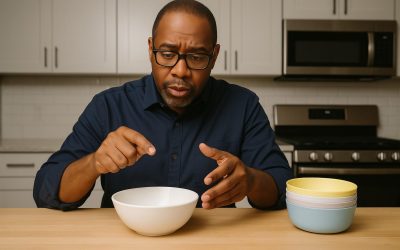As an Amazon Associate I earn from qualifying purchases.
Reheating fried rice can transform it from a simple leftover into a delicious, almost-new meal. Whether you’re looking to restore the fresh taste and perfect texture of yesterday’s takeout or you’ve cooked a batch in advance, knowing how to heat up fried rice properly is key to enjoying its best flavor and avoiding any soggy disappointments. In this guide, we’ll walk you through the best techniques to rejuvenate your fried rice, ensuring it remains as enticing as when it was first served.
Overview of the Challenges in Reheating Fried Rice
Reheating fried rice presents several challenges that can impact the quality and safety of the final dish:
- Dryness and Hardness: Rice grains can lose moisture and become hard when refrigerated. Reheating it improperly can exacerbate this issue, leading to a dry and unappetizing texture.
- Uneven Heating: Microwaves and other quick reheating methods can heat food unevenly, causing some parts of the fried rice to be hot while others remain cold. This not only affects taste and texture but can also pose a health risk if the rice isn’t heated to a safe temperature throughout.
- Loss of Flavor: The delicate flavors in fried rice, such as garlic, onions, or herbs, can diminish over time. During reheating, these flavors can further degrade or become unbalanced.
- Texture Changes: Ingredients like vegetables and eggs in fried rice can become overcooked and mushy if reheated for too long. Maintaining the integrity of these components is crucial for a pleasant eating experience.
- Food Safety Concerns: Rice is particularly susceptible to foodborne bacteria like Bacillus cereus. If it’s not stored properly at the right temperature and reheated to at least 165°F (74°C), there’s a risk of food poisoning.
- Oil Redistribution: The oils and fats used in cooking fried rice can solidify when cooled and need to be evenly redistributed upon reheating to avoid greasiness or dry spots.
Addressing these challenges requires careful choice of reheating method and attention to detail to ensure the fried rice is both safe and delicious when served again.
Importance Of Maintaining Texture And Flavor During Reheating
Maintaining the texture and flavor of fried rice during reheating is crucial for several reasons:
- Preserving Quality: The appeal of fried rice largely lies in its unique texture—crispy yet tender grains interspersed with well-cooked vegetables and proteins. Proper reheating ensures that these qualities are not lost, closely mimicking the freshness and appeal of newly cooked rice.
- Enhancing Enjoyment: The sensory experience of eating—encompassing taste, smell, and texture—greatly affects how much we enjoy our food. By preserving the texture and flavor, the eating experience remains satisfying and enjoyable, rather than a mere consumption of leftovers.
- Avoiding Waste: When food is not reheated properly and loses its appeal, it is more likely to be discarded. Properly reheating fried rice to retain its desirable qualities can reduce food waste.
- Health and Safety: Properly reheating food not only maintains its quality but also ensures safety. Reaching the correct internal temperature during reheating can prevent the growth of bacteria, making the dish safe to eat.
- Economic Value: For many, fried rice can be a cost-effective meal choice, particularly when using leftovers to create a new dish. Maximizing the flavor and texture upon reheating enhances the value of the meal, stretching the economic benefits further.
In essence, the proper reheating of fried rice is about more than just warming up a dish; it’s about recreating an enjoyable eating experience that is safe, satisfying, and economical.
Food Safety Considerations
Food Safety Considerations for Fried Rice
Proper handling and storage of leftover fried rice are crucial to ensure that it remains safe to eat when reheated. Here are best practices and tips to keep in mind:
Best Practices for Storing Leftover Fried Rice:
- Cool Quickly: To minimize the risk of bacterial growth, cool leftover fried rice quickly. Ideally, it should be cooled to room temperature within two hours and then refrigerated.
- Refrigerate Promptly: Store the cooled fried rice in the refrigerator within two hours of cooking. Delaying refrigeration can allow harmful bacteria to grow.
- Airtight Containers: Use airtight containers to store fried rice. This helps to prevent contamination and also retains moisture, keeping the rice from drying out.
- Keep Refrigerated Temperature Low: Ensure your refrigerator is set below 40°F (4°C). This temperature inhibits the growth of most bacteria.
- Consume Quickly: Ideally, consume leftover fried rice within one to two days. The longer it is stored, even under refrigeration, the higher the risk of bacterial growth.
Recognizing When Fried Rice Should Not Be Reheated and Consumed:
- Off Odor: Any unpleasant or sour smell is a clear indicator that the fried rice has gone bad and should not be consumed.
- Visible Mold: If you see any mold growth, discard the fried rice immediately. Mold can produce harmful toxins that are not destroyed by cooking.
- Slimy or Sticky Texture: A change in texture, such as sliminess or an unusually sticky feel, suggests bacterial growth.
- Stored Too Long at Room Temperature: If the fried rice was left out at room temperature for more than two hours, it should not be eaten. Bacteria can grow rapidly at room temperatures.
- Older Than Three Days: Even if it looks and smells fine, fried rice stored in the refrigerator for over three days increases the risk of food poisoning and should not be reheated or consumed.
By adhering to these storage and safety guidelines, you can help ensure that leftover fried rice remains delicious and safe to eat when reheated.
Preparation For Reheating
To ensure your fried rice retains its texture and flavor when reheated, proper preparation is key. Here are some steps and tips on how to prepare fried rice for reheating and how to add moisture back into the dish:
How to Prepare Fried Rice for Reheating:
- Portion the Rice: If possible, only reheat the amount of fried rice you plan to eat. Repeated heating and cooling can degrade the quality and safety of the dish.
- Break Up Clumps: Before reheating, break up any clumps of rice with a fork or your fingers. This helps the heat distribute more evenly, preventing cold spots.
- Choose the Right Method: Depending on your resources and the amount of rice, choose a reheating method that best suits your needs (microwave, stove, or oven). Each method requires slightly different preparation to maximize results.
Adding Moisture Back to Fried Rice:
- Sprinkle Water or Broth: Before reheating, lightly sprinkle the fried rice with water or broth. This adds moisture that helps to steam the rice during the reheating process, preventing it from drying out.
- Cover During Heating: If using a microwave, cover the rice with a microwave-safe lid or a damp paper towel. This traps steam and evenly distributes moisture. If reheating on the stove, you can also cover the pan for part of the heating time to similar effect.
- Stir in Sauces or Oils: A small amount of soy sauce, sesame oil, or another favorite sauce can not only add moisture but also enhance the flavor. Add these sparingly during the reheating process, especially if using a stove, to refresh the flavor profile and prevent dryness.
- Add Fresh Ingredients: Introducing fresh vegetables or a splash of water while stir-frying on the stove can reintroduce moisture. These ingredients release water as they cook, helping to moisten the rice.
These preparation steps can greatly improve the quality of reheated fried rice, making it nearly as good as when it was freshly made.
Reheating Methods
Reheating fried rice can be done using various methods, each with its own advantages. Here’s how you can reheat fried rice using a microwave, stovetop, oven, and air fryer:
Microwave:
Pros: Quick and convenient.
Cons: Can heat unevenly.
Steps:
- Place the fried rice in a microwave-safe bowl.
- Sprinkle a little water over the rice to add moisture.
- Cover the bowl with a microwave-safe lid or a damp paper towel to trap steam.
- Heat on high for about 1-2 minutes, stirring halfway through to ensure even heating.
Stovetop:
Pros: Best for restoring the “fried” texture.
Cons: Requires more attention during reheating.
Steps:
- Heat a few tablespoons of water or broth in a skillet over medium heat.
- Add the fried rice and stir frequently to prevent sticking and ensure even heating.
- If desired, add a small amount of oil or butter for extra flavor and to help restore the fried texture.
- Cook until the rice is thoroughly heated, typically about 5-7 minutes.
Oven:
Pros: Good for large quantities.
Cons: Slower than other methods.
Steps:
- Preheat the oven to 300°F (150°C).
- Spread the fried rice in an even layer in an oven-safe dish.
- Sprinkle some water over the rice and cover the dish with aluminum foil to trap the steam.
- Reheat for about 15-20 minutes, checking occasionally to ensure it doesn’t dry out.
Air Fryer:
Pros: Quick and can help crisp up the rice slightly.
Cons: Not ideal for very large quantities.
Steps:
- Preheat the air fryer to 350°F (175°C).
- Spread the fried rice evenly in the air fryer basket. Lightly spray or drizzle with oil if desired for extra crispness.
- Heat for about 3-5 minutes, shaking the basket halfway through to ensure even heating.
Each of these methods can effectively reheat fried rice, but the choice often depends on the quantity of rice, the desired texture, and the appliances available.
Tips For Best Results
Ensuring your reheated fried rice tastes as good as fresh requires a few clever tricks. Here are some tips for best results, focusing on even heating, enhancing flavor with fresh ingredients, and adjusting seasoning:
Ensuring Even Heating
- Stir Frequently: Whether using a microwave, stovetop, or even an air fryer, stir your rice at regular intervals. This helps distribute heat more evenly and prevents certain spots from becoming too hot or staying cold.
- Use Shallow Dishes: When reheating in a microwave or oven, spread the rice in a shallow, even layer. This maximizes the surface area exposed to heat, reducing the chances of cold spots.
- Thaw First: If your fried rice is frozen, letting it thaw in the refrigerator overnight can lead to more uniform heating when you reheat it.
Adding Fresh Ingredients During Reheating
- Incorporate Fresh Vegetables: Adding a handful of fresh chopped vegetables (like bell peppers, peas, or green onions) can introduce moisture and revitalize the overall dish.
- Include Protein: Stir in some fresh or leftover protein such as cooked chicken, shrimp, or tofu for a more complete and satisfying meal.
- Use Herbs and Spices: Fresh herbs (like cilantro or basil) and a pinch of spices (like curry powder or black pepper) added towards the end of reheating can brighten up the flavors.
Adjusting Seasoning After Reheating
- Taste First: Always taste your rice after reheating and before adding extra seasoning. The flavors can change during storage and reheating.
- Add Sauces Sparingly: A little soy sauce, sesame oil, or fish sauce can go a long way in restoring the original flavor of fried rice. However, add these sparingly to avoid overpowering the dish.
- Balance Flavors: If the rice tastes bland, a pinch of salt can help. If it’s dry, a small amount of broth during reheating can improve both taste and texture. For a touch of acidity, a squeeze of lemon or lime juice can be very effective.
By following these tips, you can significantly enhance the quality of reheated fried rice, making it nearly as enjoyable as when it was freshly made.
Common Mistakes To Avoid
Reheating fried rice can sometimes go awry if not done carefully. Here are some common mistakes to avoid to ensure your reheated fried rice is safe, delicious, and retains a pleasant texture:
Overheating That Leads to Dry and Hard Rice
- Avoid High Heat for Too Long: Excessive heat can cause the rice to lose moisture quickly, turning it dry and hard. Whether using a microwave, stovetop, or oven, moderate the heat and cooking time.
- Do Not Overcook: Keep a close watch and check the rice periodically. Once it’s hot throughout, stop heating.
- Use Moisture: Always add a little water, broth, or even a few drops of oil when reheating to help the rice retain or regain moisture.
Underheating Which Could Lead to Food Safety Issues
- Heat to the Right Temperature: Ensure that all parts of the rice reach at least 165°F (74°C). This temperature is necessary to kill any potentially harmful bacteria.
- Stir and Check Evenly: Stirring the rice occasionally helps distribute the heat evenly, preventing cold spots which can be a breeding ground for bacteria.
- Use a Food Thermometer: For the best safety measure, check the temperature of the rice with a food thermometer.
Mixing Too Many Different Reheating Methods
- Stick to One Method: Using multiple reheating methods for the same portion of rice can lead to uneven cooking and textural issues. Choose the best method for your needs and stick with it for the entire reheating process.
- Understand Each Method’s Benefits: Microwaves are quick but can heat unevenly, stovetops offer better control for evenly heating and restoring texture, ovens are great for larger batches, and air fryers can provide a crisp finish. Match your method to your desired outcome.
- Avoid Frequent Changes: Switching between methods, like starting in a microwave and then moving to a stove, can result in uneven texture and overcooked spots.
By avoiding these common mistakes, you can ensure that your reheated fried rice is just as satisfying as when it was freshly made, both in terms of safety and taste.
Serving Suggestions
Reheated fried rice is versatile and can be served in various delicious ways. Here are some ideas for complementing it with other dishes and transforming it into a new meal:
Serving Suggestions: Complementing Reheated Fried Rice
- Pair with Protein: Serve the reheated fried rice with sides of protein like grilled chicken, roasted shrimp, or tofu. These can add nutritional value and make for a more rounded meal.
- Accompany with Soup: A light soup, such as miso soup, hot and sour soup, or a simple vegetable broth, can complement the hearty texture of fried rice.
- Include a Salad: A fresh Asian-style salad, featuring ingredients like cucumber, carrots, and a sesame dressing, can add a crisp and refreshing contrast to the warm rice.
- Serve with Spring Rolls or Dumplings: For a fuller meal, include a side of spring rolls or dumplings, either homemade or from your favorite takeout spot.
- Egg Toppings: A fried or soft-boiled egg on top of the rice can enrich the dish, adding a creamy texture that blends beautifully with the rice.
Transforming Reheated Fried Rice into a New Meal
- Fried Rice Bowls: Add various toppings such as avocado slices, sliced radishes, seaweed, or kimchi to the reheated fried rice to create a vibrant and nutritious bowl.
- Stuffed Peppers: Stuff hollowed-out bell peppers with fried rice and top with cheese. Bake until the peppers are tender and the cheese is melted for a delightful dish.
- Fried Rice Lettuce Wraps: Spoon the reheated fried rice into lettuce cups and top with hoisin sauce, sriracha, or a sprinkle of crushed peanuts for a light, crunchy meal.
- Pineapple Fried Rice: Mix in diced pineapple, cashews, and scallions to the reheated rice for a sweet and savory twist.
- Kimchi Fried Rice: Stir in some kimchi and a bit of its juice during reheating for a spicy, tangy version of your fried rice.
These ideas can help elevate your reheated fried rice from a simple leftover dish to an exciting meal that feels entirely new and appetizing.
Frequently Asked Questions (FAQ’s)
Here are some expert questions and answers on how to heat up fried rice effectively:
Q: What is the best method to reheat fried rice to maintain its texture?
A: The best method for maintaining texture is using the stovetop. Heat a pan on medium heat, add a small amount of oil or water, and then stir-fry the rice. This method helps to keep the rice grains separate and adds a slight crispness that is reminiscent of freshly fried rice.
Q: Can fried rice be reheated in a microwave?
A: Yes, fried rice can be reheated in a microwave. To prevent it from drying out, sprinkle some water over the rice before heating and cover it with a microwave-safe lid or a damp paper towel. This creates steam, which helps to keep the rice moist. Heat in short intervals, stirring in between to ensure even heating.
Q: Is it safe to reheat fried rice more than once?
A: Reheating fried rice more than once is not recommended. Each reheating cycle increases the risk of foodborne illnesses due to the potential growth of bacteria. It is best to only reheat the portion of rice you plan to eat and keep the rest refrigerated.
Q: How can I add moisture back to fried rice that has dried out?
A: To add moisture back to dried-out fried rice, sprinkle a few tablespoons of water or broth over the rice before reheating. You can also stir in a small amount of oil or butter to help the grains regain some of their softness and prevent sticking.
Q: What are the signs that reheated fried rice should not be eaten?
A: If the reheated fried rice has an off smell, a slimy texture, or any visible mold, it should not be eaten. Also, if the rice was stored at room temperature for more than two hours before it was first refrigerated, it’s safer to discard it due to the risk of bacterial growth.
Q: How long can fried rice be stored in the refrigerator before it should be reheated and eaten?
A: Fried rice should be stored in the refrigerator for no more than one to two days before reheating and consuming. Ensure it is stored in an airtight container to minimize exposure to air and moisture, which can spoil the rice faster.
Q: Can I reheat fried rice in an air fryer?
A: Yes, an air fryer is a great tool for reheating fried rice, especially if you prefer a slightly crispy texture. Preheat the air fryer to about 350°F (175°C), spread the rice in the basket, and heat for 3-5 minutes. You might want to shake the basket halfway through to ensure even heating.
Q: What is the best way to reheat fried rice so it tastes fresh?
A: The stovetop method is generally considered the best for reheating fried rice. Heat a little oil in a pan, add the rice, and stir frequently to prevent sticking. You can add a few tablespoons of water or broth to help the rice steam and regain moisture.
Q: Can I reheat fried rice in the microwave?
A: Yes, you can reheat fried rice in the microwave. Place the rice in a microwave-safe dish, sprinkle some water over it to add moisture, and cover it with a lid or a damp paper towel. Microwave on high for about 1-2 minutes, stirring halfway through to ensure even heating.
Q: How do I prevent fried rice from drying out when reheating?
A: To prevent drying, add a small amount of water, broth, or a light drizzle of oil before reheating. This helps to reintroduce moisture and keeps the rice from becoming too dry.
Q: Is it safe to reheat fried rice?
A: Yes, it is safe to reheat fried rice as long as it was stored properly. Ensure the rice was refrigerated within two hours of cooking and consume it within 1-2 days. Always reheat to an internal temperature of at least 165°F (74°C) to ensure all bacteria are killed.
Q: How many times can I reheat fried rice?
A: It’s best to only reheat fried rice once. Multiple reheatings can increase the risk of foodborne illness and can also degrade the quality of the rice, making it dry and unpalatable.
Q: Can fried rice be frozen and reheated?
A: Yes, fried rice can be frozen for up to three months. Thaw it in the refrigerator overnight before reheating. For best results, reheat thawed fried rice on the stove or in the microwave, adding a little moisture to refresh the texture.
Q: What should I do if the fried rice tastes bland after reheating?
A: If the fried rice tastes bland, you can enhance its flavor by adding a bit of soy sauce, sesame oil, or fresh herbs after reheating. Adjust the seasoning carefully to avoid overpowering the dish.
Q: Can I add new ingredients when reheating fried rice?
A: Absolutely! Adding fresh vegetables, scrambled eggs, or additional proteins like chicken or shrimp can transform reheated fried rice into a new and exciting meal.
These answers should help anyone looking to reheat their fried rice effectively, ensuring it remains delicious and safe to eat.
Conclusion
In conclusion, mastering how to heat up fried rice is the key to transforming this beloved dish from a simple leftover to a delightful, rejuvenating meal. By choosing the right reheating method—whether it’s the microwave for convenience, the stovetop for optimal texture, or even the air fryer for a crispy finish—you can ensure that your fried rice is not only safe to eat but also deliciously satisfying. Remember to add a touch of moisture, stir frequently, and consider fresh additions to enhance flavor and variety. With these tips, your next plate of reheated fried rice will taste as good as, if not better than, the original.






